Matador Network's Blog, page 518
March 7, 2022
The 8 Magical Natural Springs in Florida for Pure Rejuvenation and Relaxation

As a lifelong Florida resident, I’ve grown to hate the tourist trap reputation the state has cultivated. When people think of Florida they often conjure up images of plastic-covered beaches or expensive, overcrowded theme parks. While I’ll admit these stereotypes do encompass a portion of the Sunshine State, they are far from the best things the state has to offer. In fact, the natural springs in Florida are perhaps the state’s best-kept secret.
They offer beauty, history, entertainment, and they are all extremely reasonably priced. Also, each spring is totally different, from family-friendly swimming holes and rivers to SCUBA and cave diving, visitors can find the vacation spot that’s perfect for them.
1. Silver Springs, Ocala
Photo: Blair Carlyle
Silver Springs isn’t only Florida’s oldest spring destination, it’s often recognized as the first tourist attraction in the state.
The famous glass-bottom boat tours began in the late 1870s and still continue today almost 150 years later. The entry fee to the park is only $2, but if you want a ticket to the glass bottom boat the price jumps to $14.84 (which is definitely worth it). On the tour, you’ll see a 600-year-old Native American dugout canoe, a boat that possibly belonged to Spanish conquistadors, and many other incredible sights.
Silver Springs is the largest artesian limestone spring in the world (the sun reflecting off of the limestone is what gives the water its silver sheen, hence the name). As if it couldn’t get any better, there are wild monkeys in the forest surrounding the spring and if you’re lucky you’ll catch a glimpse of them in the trees. The only downside to Silver Springs is there is not a swimming area, but there are kayak rentals on the property for those who still want to get out on the water. The park also offers campgrounds for RVs, tents, along with cabins to rent. Silver Springs is a perfect place for families to learn about Florida history in a spectacular setting without breaking the bank.
2. Juniper Springs, Ocala National Forest
Photo: Blair Carlyle
If I had only one word to describe Juniper Springs the word that comes to mind is magical. The spring itself isn’t very big and can get pretty crowded on weekends, but if you find the right time to go (I opted for mid-afternoon on a Tuesday), you will have a wonderful time in a truly enchanting place.
Constructed in the 1930s by the Civilian Conservation Corps, Juniper Springs has a beautiful swimming area, a campground, a rotating water mill, and a nationally recognized seven-mile canoe and kayak trail. There are remnants of the park’s history scattered all around the grounds, from crumbling chimneys out in the forest to the old stone bridge behind the mill.
The main attraction of Juniper Springs is its canoe trail. Named one of the top 25 canoe runs in the US by ReserveAmerica, the river meanders through old-growth forest under a canopy of live oaks and Spanish moss before opening up into a wetlands area alive with wading birds and wildlife (including rare albino gray squirrel, otters, and American eels). The park charges $8 for day use and $31 for overnight camping.
3. Salt Springs, Ocala National Forest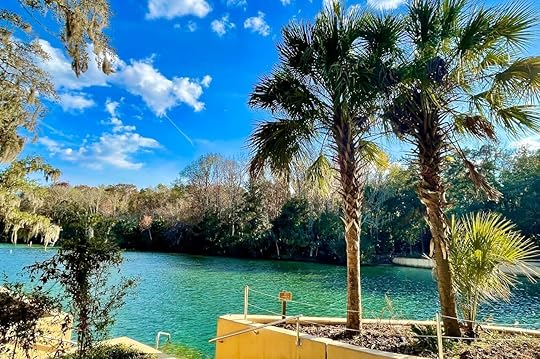
Photo: Blair Carlyle
Salt Springs is located way out in the Ocala National Forest, along with Alexander Springs and Juniper Springs. Salt Springs is not as glamorous as some of its counterparts but it’s still an incredibly pleasant spot for an afternoon or weekend adventure — it’s especially good to know if Juniper and Alexander Springs are overcrowded.
Its primary attraction is the swimming area, which is fed by 52 million gallons of freshwater a day. The minerals in the water give it a slightly salty taste and caused early travelers to believe it had medicinal healing powers. There is a full ground for RV hookup and the park allows consecutive camping for up to two weeks. It costs $8 to enter the park and $23 a night for primitive camping. There’s also a nice two-mile hike that ends in a birdwatching observation deck for those who want to do more than lounge in the sun. Manatees are often seen in the springs so be sure to bring binoculars and a camera!
4. Rainbow Springs, Dunnellon
Photo: Blair Carlyle
While each spring in Florida offers something slightly different, Rainbow Springs has it all. A wonderful swimming area, a crystal clear river to kayak on, beautiful hiking trails, a rich history…the list goes on and on.
The spring shimmering beneath the Spanish moss, magnolia trees, and palm fronds conjures the image of the Garden of Eden. In 1889 the property began as a phosphate mine until the mines were exhausted in the mid-1900s. From there it was turned into a “jungle oasis” tourist attraction, with waterfalls being built where the mines once stood and exotic animals imported to draw crowds.
Today, you can still see the remains of the waterfalls, the aviary, and animals cages around the park. There’s also a beautiful swimming area with crystal clear water that stays a steady 72 degrees year-round and stretches east and west to become the Rainbow River.
The park has tubes and kayaks to rent, along with life jackets, snorkeling equipment, and other flotation devices for sale in the gift shop. There are four different trails to hike with distances ranging from the 0.7 mile campground loop to the 3.5 mile White and Yellow Trail. Rainbow Springs offers both RV and tent camping, though be advised to book your spot in advance. The park costs $2 for day use and $23 for overnight tent camping.
5. Ichetucknee Springs, Ichetucknee Springs State Park
Photo: Blair Carlyle
About an hour north-west of Gainesville lies Ichetucknee Springs State Park. The Ichetucknee is a crystal-clear river that winds through a hauntingly beautiful old growth cypress swamp.
Turtles sun themselves on fallen longs and wading birds patrol the shoreline as visitors meander south on the river’s steady current. Glittering mother-of-pearl shimmers on the bottom of the river as the sun glints off of various freshwater shells and an army of cypress knees stand guard throughout the forest.
The Ichetucknee River is another one of Florida’s incredible spots and is the perfect place to spend a day or a week. The river has various entry points depending on how long you want to be on the water. If you’re tubing you can choose between the midpoint launch (two-hour trip to the last take out), or Dampier’s landing (one hour trip to last take out). If you’re canoeing you can venture up the river to the north section and spend a whole day rowing through the river.
The park costs $6 per vehicle (two to eight people), $4 for single-occupant vehicles, and $2 for pedestrians without vehicles. Tubes are available to rent at the gift shop and there are tram and shuttle services available to take you up and down the river for a small fee as well. The park also has tent and RV camping at $20 a night for a two-person primitive camp spot and $40 a night for AMP RV camping.
6. Devil’s Den, Williston
Photo: Blair Carlyle
When you first pull into Devil’s Den, it doesn’t look like much. In fact, it kind of looks like you just pulled into someone’s backyard. But the magic of the spring is underground, where an ancient subterranean spring bubbles at a constant 72 degrees year-round.
Gazing down into the gaping maw of the spring, you’ll be struck by its deep shimmering blue water and prehistoric geology. If you’re SCUBA certified this spring is a must-see. It stretches 54 feet deep and is filled with ancient rock formations and fossils (though the spring kindly asks that if you find anything please leave it be). Keep in mind there is no free swimming allowed in the spring! Snorkeling is by appointment only, but the park is definitely intended for SCUBA divers specifically.
The spring has a swimming pool for non-divers and is less than a mile from the beautiful Cedar Lake Woods and Botanical Gardens for anyone who accompanies a diver and is looking for something to do while their friend explores the den. Admission for divers is $38, and the park has SCUBA supplies for rent on-site ($45 for a the full SCUBA package including mask, snorkel, fins, booties, regulator, BCD, tank, wetsuit, weights, and an LED light). The park also has RV hookups for $35 a night, tent camping for $12, and cabins to rent for $140 per night.
7. Rock Springs, Kelly Park, Apopka
Photo: Blair Carlyle
Whether you want to soak in a swimming area or tube down a lazy river, Rock Springs is the perfect place for an afternoon with the little ones. The park also has an incredibly large recreation area with countless picnic tables and grills to use, along with a playground.
The river is calm and shallow, making it ideal for youngsters who aren’t ready for longer river runs like Ichetucknee or Rainbow River. That said, there is also a more advanced run for kayakers and canoers who want a little more excitement. Tubes are available to rent for $7 at the Rock Springs Bar and Grill. Admission is $3 for one to two people, $5 for three or more, and $10 per bus or commercial van.
8. Alexander Springs, Altoona
Photo: Blair Carlyle
Alexander Springs is one of the best springs in Florida for relaxation. There isn’t a river to float down, or a cave to explore, but what Alexander Springs lacks in activities, it makes up for in atmosphere.
Just 16 miles south of Juniper Springs, Alexander Springs sits nestled in the Ocala National Forest. The main attraction is the enormous mouth of the spring, which is located 25 feet below the surface and pumps at least 64.4 million gallons of water per day. Swimmers and SCUBA divers alike can explore beautiful limestone formations as well as fallen trees on the bottom of the spring. There are also picnic tables and grills scattered throughout the recreation area for anyone who wants to cook lunch out on the water. The park also offers primitive camping for $31 a night, as well as RV hookups for a slightly larger fee. Entry into the park is $6 per person. 
March 4, 2022
TikTok can help plan your vacation

2020 was the year of closed borders, grounded aircraft, and endless days working from home. Traveling and exploring new places was off the table. What was on the table, however, was TikTok.
Like many during that time, TikTok was my escape. My FYP (For You Page) was a positive space filled with loveable animals, hilarious skits, and great travel content.
In early 2020, when I was oblivious to the troubles to come our way, I had created a vision board where I had pinned photos of my bucket-list destination: Greece. That whole year, I dreamed of the day I’d be able to dive into the country’s clear blue waters and explore the labyrinth streets of Santorini. By 2021, after spending countless hours on the app, TikTok’s top-notch algorithm was inundating me with content about the Aegean Islands. One of the videos I obsessed about, “Top Beaches in Milos” (an island I had never heard of), included a familiar-looking beach, Fyropotamos. Lo and behold, that exact picturesque setting was on my 2020 vision board. I took it as a sign. I was going to go to Greece, and TikTok would help me plan my vacation.
@annitakatee vision board to reality#manifestation works
#greece #travel #milos #visionboards ♬ original sound – Taylor Swift
TikTok, lead the way to vacation perfection
The beautiful thing about the travel content on TikTok is that it’s made of stunning snippets that leave you wanting more, pushing you to go see the places featured in the videos with your own eyes.
Travel content is one of the most popular video categories on the app, with #travel being viewed over 67.6 billion times at the time of writing. But even with the huge amount of content and over one billion active monthly users worldwide, I never found a video of someone using TikTok to plan their vacation.
So, I decided to give it a go. And to make sure that letting TikTok plan my vacation was not a total disaster, I created a four-step process:
1. Research by hashtagsI started by searching for specific hashtags. By using relevant tags such as #santorini #toursantorini #thingstodoinsantorini, I was able to find activities, accommodation, great places to eat, and narrow down appropriate content. For example, when I searched #santorini, many videos featured cruising around the island. Inspired by this TikTok video, I booked a sunset cruise and it was one of the most magical experiences of my life.
2. Save every videoIf there’s anything at all that I liked, even if it was clearly out of my budget, I still saved it and worried about the finer details later.
3. Categorize your favorite picksI started by choosing four categories that would encompass what I was looking for:
AccommodationActivities/EntertainmentTransportationFood/CultureFrom there, I broke each of them down into three categories:
AccessibilityAffordabilityAestheticsAfter doing this, every saved video had a home and was filed accordingly.

Photo: Annita Katee
As for the clips I knew featured places that were out of my budget, I thought about what it was that I liked about them and tried to find that element elsewhere. This process also made me rethink what I really wanted for my trip. For example, initially, I was determined to stay at a place that had an infinity pool. But when I thought about it, I realized that I was planning on spending very little time at my accommodation besides sleeping, so while aesthetically pleasing, it wasn’t worth the extra money.
@matadornetwork #Mykonos is a beautiful #GreekIsland known for its beaches and nightlife@handluggageonly #greecetravel #traveltiktok #quickbooksvictorypose ♬ Chiquitita x Twilight – twibytez
4. Get booking
After I narrowed down my top contenders, it was time to schedule and book my trip.
Thanks to a Google Flights hack TikTok video, I had managed to book a $600 return flight to Athens, so I knew exactly where and when I was starting and ending my trip. I had also made the decision to limit my trip to four places: Athens, Mykonos, Santorini, and the vision board island that started it all, Milos. With a large blank piece of paper and a drawn-out calendar, I started filling in the potential activities and ideal resorts I had seen on TikTok, and the transport options between them.
Then it was time for the real nitty-gritty of actually booking. Some places that I loved had no availability, but because I had a long list of options saved on Tiktok, I was able to make at least one work.
Tried and tested: TikTok can help you plan a vacationWhat I loved most about using this method was that TikTok’s travel content was a pretty fresh and authentic view of what to expect. I went all in trusting TikTok when booking and it worked beautifully.
@annitakatee Athens day 2 #athens #whattodoinarhens #greece #travel #vacation #acropolis #visitgreece ♬ Fly Away – Tones And I
That said, I may have been very lucky, so don’t skimp on a little Googling and review-reading before you book. For example, some research would have shown me that public transport was very basic on Greek islands and that buses only took cash on board, which I was not prepared for.
Letting TikTok plan my vacation was a successful strategy, and one that I’m ready to try again. I hope that my experience proves that TikTok can help plan your vacation, too. 
New Traveler Survey Ranks the Top 20 Annoying Types of Airline Passengers

When flying, you’re at mercy of your neighbors with very little space between you — particularly when you book economy class. The best-case scenario is that your fellow passengers have a solid understanding of aircraft etiquette, but if not, the most annoying passengers can make even the shortest flights feel like they’re dragging on with no end in sight.
Whether it’s kicking your seat, drunk passengers, or noisy children, we all have behaviors that annoy us to no end. But are your gripes the same as everyone else’s, or are you making a bigger stink than you should be? The travel blog Only Wanderlust conducted a survey of more than 1500 airline travelers to see what behaviors are the most annoying, and which ones are not so much. Then they broke down 20 types of passengers that people get annoyed at by percent of total responses.
The most annoying travel passengers ranked:The Kicker — Your seat being kicked — 9 percent.The Stinker — A passenger with a bad body odor — 8.7 percent.The Loud & Proud — Other passengers talking loudly — 7.3 percent.The Leaner — Your seat being pulled or leaned on — 7.3 percent.The Drunk Flyer — Drunk or tipsy flyers — 7.1 percent.The Noisy Kid — Crying babies or children — 6.7 percent.The Recliner — The seat in front of you reclining — 5.9 percent.The Scented — A passenger wearing strong perfume or cologne — 5.7 percent.The Not-So-Masked — Passengers not wearing their masks properly — 5.4 percent.The Loud Sleeper — A passenger snoring — 5.2 percent.The Stinky Feet — A passenger removing socks or shoes — 4.2 percent.The Eager — Passengers standing and getting bags as soon as the plane lands — 3.8 percent.The BYO Meal — A passenger bringing on smelly food — 3.3 percent.The Weak Bladder — People getting out of their seats regularly — 3.2 percent.The Chatty Cathy — Your neighbor talking to you through the flight — 3.2 percent.The Armrest Hog — Your neighbor taking up all of the armrest — 2.7 percent.The Too Relaxed — A passenger putting their feet up on or between your seat — 2.5 percent.The Clapper — Passengers applauding when the plane lands — 2.5 percent.The Manspreader — Passengers spreading their legs, aka manspreading — 2.5 percent.The Night Owl— Bright phone or tablet screens on night flights — 2 percent.The recliner ranking as the seventh most annoying behavior at 5.9 percent brings up an interesting debate that seems to come up over and over again: If the seat reclines, why shouldn’t you be able to use it? Two out of three travelers say you have the right to recline, and Alaska Air, American Airlines, and Southwest Airlines told Only Wanderlust that there are no policies on the books for this (other than being in an upright position for takeoff and landing).
So the next time you’re on a flight, be kind to your fellow passengers and flight attendants. Avoid kicking the seat in front of you, and shower before arrival but skip the perfume and cologne. And, if you truly can’t stand the behaviors of other passengers, you can always spring for a more isolated seat in business or first class. 
Learn an endangered language

There’s a map on UNESCO’s website that lets you see all the endangered languages. The “Interactive Atlas of the World’s Languages in Danger” shows languages at five levels of threat, each associated with a color, from Vulnerable (white) to Definitely Endangered (yellow), Severely Endangered (orange), Critically Endangered (red), all the way to Extinct (black).
The UNESCO’s five-level of threat to languages is explained on their website as follows:
Vulnerable: Most children speak the language, but it may be restricted to certain domains (e.g. home)Definitely endangered: Children no longer learn the language as a mother tongue in the homeSeverely endangered: language is spoken by grandparents and older generations; while the parent generation may understand it, they do not speak it to children or among themselvesCritically endangered: The youngest speakers are grandparents and older, and they speak the language partially and infrequentlyExtinct: There are no speakers leftWhen selecting to see all the Critically Endangered languages in the world, the map floods with red pins. That single category includes 577 languages, which makes up roughly 10 percent of all the world’s languages. (Linguists estimate that there are over 5,000 languages in the world).

Photo: UNESCO
This alarming number about the loss of the world’s languages is supported by experts. The Linguistic Society of America, explains in grim but simple terms that language diversity is on its way out.
“Some linguists believe the number [of languages in the world] may decrease by half; some say the total could fall to mere hundreds as the majority of the world’s languages — most spoken by a few thousand people or less — give way to languages like English, Spanish, Portuguese, Mandarin Chinese, Russian, Indonesian, Arabic, Swahili, and Hindi. By some estimates, 80% of the world’s languages may vanish within the next century.”
But all hope is not lost for endangered languages. Some apps have given them a much-needed boost. By creating courses that allow anyone to learn some of those endangered languages from their laptop or phones, they are drumming up interest and slowly revitalizing them before they are lost forever.
Here are five endangered languages available for you to learn online before it’s too late.
1. Where can I learn the Hawaiian language?Listed as Critically endangered by UNESCO, the Hawaiian language suffered terribly after the US took over the archipelago of Hawaii in 1896 and banned its use in schools. However, ‘Ōlelo Hawai‘i has been experiencing a revival in the past few decades. In 2019, NPR reported that there were 2,000 students learning in 21 Hawaiian language immersion schools on the archipelago, and a 2016 government report estimates that over 18,000 people speak Hawaiian at home in the state of Hawaii.
Those who want to learn the endangered Hawaiian language have been able to do so for free on the Duolingo app since October 2018. As of March 2022, it is the language of choice for 586,000 Duolingo users. Hawaiian classes are also available on Memrise.
Read what it’s like for a Hawaiian to learn the language of her people on Matador Network.
2. Where can I learn Yiddish?UNESCO lists two forms of Yiddish as Definitely Endangered: European Yiddish and Israeli Yiddish. The Endangered Languages Project, however, classifies two different dialects of Yiddish, Eastern and Western Yiddish as At Risk and Threatened, respectively.
There are several Yiddish dialects that differ according to geographical locations, and while all of them may not be endangered, all of them have had fewer and fewer speakers over the past 85 years. The Yivo Institute for Jewish Research estimates that there were nearly 11 million Yiddish speakers before WWII broke, while today there are only between 500,000 and one million.
“In the 21st century, most people who speak Yiddish in their daily lives are Hasidim and other Haredim (strictly Orthodox Jews) [….] mainly in the United States, Canada, Europe, and Israel,” explains the Yivo Institute for Jewish Research in a 2014 report.
Despite the varied forms of the language spoken throughout the world, there is a standardized form of Yiddish that works as a basis to teach the language which has been available for free to all keen learners on Duolingo since April 2021. (There are currently 481,000 Yiddish learners on the app). The website Yiddishpop is another good learning platform recommended by Yiddish experts, but there is no app available. There are also courses available on the Memrise app.
For a taste of Yiddish, check out Matador Network’s “10 Yiddish Proverbs that will Make You Smile”.
3. Where can I learn Cornish?According to The Guardian in 2013, Cornish is one of 10 Indigenous languages spoken in the British Isles, namely:
Angloromani (a mix of English and Romani spoken by some Traveler people in England and Wales)British Sign LanguageEnglishGaelic (AKA Scottish Gaelic spoken in Scotland)Irish (AKA Irish Gaelic, spoken throughout Ireland, the official language of the Republic of Ireland alongside English)Manx (AKA Gaelic Manx, revived on the Isle of Man)Scots (a term encompassing a variety of Scottish dialects, including Doric and Shetlandic)Shelta (language used by Traveler people in Ireland and Britain)Welsh (spoken in Wales)Cornish is a pre-Roman Celtic language from the Cornwall region of England that is closely related to Welsh (spoken in Wales) and Breton (spoken in Brittany, a region of France). While UNESCO lists Cornish as Critically Endangered, The Endangered Languages Project is a little more optimistic by classifying it as Awakening, adding the following information:
“Cornish is a ‘revived’ language; it once had no surviving native speakers, with the last known fluent speaker having passed away by the year 1800, but has been learned by many in more recent times.”
Language aficionados who want to be part of the Cornish revival can take one of the many courses available on the Memrise app or get a good introduction to the language via the website Say Something in Cornish. Alternatively, you can check out BBC Cornwall’s Cornish language course or take Cornish classes via the University of Exeter online.
To learn more about Celtic nations and languages, check out Matador Network’s “The 6 Celtic Nations Around the World and what Differentiates Them”
4. Where can I learn Greenlandic?Greenlandic, also known as Kalaallisut, is the dialect of West Greenland and the official language of the country. There exist three main dialects in Greenlandic: West Greenlandic, East Greenlandic, and Inughuit Greenlandic (also sometimes referred to as North Greenlandic or Polar Eskimo).
All the Greenlandic dialects belong to the Inuit family of languages which encompasses 20 languages or dialects spoken by around 65,000 people throughout Alaska, Canada, and Greenland.
UNESCO lists Kalaallisut as vulnerable but classifies the other two dialects Definitely Endangered. The Endangered Languages Project also classifiesKalaallisut as Vulnerable.
You can learn Greenlandic/Kalaallisut online on Memrise and Utalk.
Familiarize yourself with the different dialects by checking out the Visit Greenland video below:
Learn more about Greenland’s culture by reading “Greenland’s National Costume is a Work of Art” on Matador Network.
5. Where can I learn Navajo?Listed as Vulnerable by UNESCO and At Risk by the Endangered Languages Project, Navajo, also known as Diné Bizaad, is an Indigenous language spoken in Arizona, New Mexico, Utah, and Colorado.
According to the language expert at Rosetta Stone, Navajo is still spoken by 100,000 people (the Endangered Languages Project estimates there are 120,000 speakers) but its usage is declining fast. That’s why Rosetta Stone has developed the Navajo Rosetta Stone app available for purchase here.
You can also learn Navajo on Duolingo for free. The language-learning app made the course available in October 2018, at the same time as its Hawaiian course. Today, there are 293,000 Navajo learners on the app.
Cudoo and Memrise also offer Navajo language courses online.
Read “Visiting Indigenous Communities is a Delicate Balance of Respect and Education” on Matador Network if you want to visit the Navajo Nation. 
People are Booking Airbnbs in Ukraine Right Now for All the Right Reasons

It’s hard to think of a reason to book an Airbnb in a country that’s in the middle of a war. But that’s exactly what some Airbnb users are doing in an effort to put money straight into Ukrainian citizens’ pockets.
To be clear, the people making Airbnb bookings in Ukraine have no intention of traveling to a war zone and staying in the homes. The effort is solely an innovative way to get money directly to the hosts. It’s estimated that hundreds of Ukraine Airbnbs have been booked so far, according to ITV.
HOW TO HELP – just booked a Kiev AirBnb for 1 week, simply as a means of getting money directly into the hands of Kiev residents. It's really cheap and can make a small difference right now. Please share this idea #Ukraine #Russia #StopWarInUkraine #StopPutinNOW #UkraineRussiaWar pic.twitter.com/7yQDLYRkph
— DiMaggio.eth (@DimaggioEth) March 3, 2022
“Hello Maria, my wife and I have just booked your apartment for one week, but of course we will not be visiting. This is just so you can receive some money,” one couple wrote to an Airbnb host who booked a stay for March 3-10 in Kyiv.
Following requests, the company has waived all of its fees on Ukrainian Airbnb properties, which can range anywhere from three to 15 percent, to ensure the entire amount of the booking goes to the Airbnb host. This move comes as Airbnb has suspended all of its properties in Russia.
It’s important to note that some Airbnbs are listed by agencies instead of individuals. Travel expert Simon Calder warned people to be careful, as the good deed could be abused by scammers.
“Lots of talk about booking random Airbnbs in Ukraine and paying for them with no intention of staying, to transfer cash to the country,” he posted on Twitter. “Warning: were I a Russian scammer, I would be setting up fake Airbnbs in Kiev and Odessa as fast as I could to cash in on those noble intentions.”
Feeling helpless, I booked an @Airbnb in Kiev for a stay this week knowing the money would go direct to someone there. There were no air bnb fees attached. This is the beautiful response I got. She also told me they know the world supports them and they can all feel it
pic.twitter.com/j9h88AEvit
— Kate Hutchison (@hutch8) March 3, 2022
Airbnb has taken more direct steps to help people impacted by the Russian invasion of Ukraine by offering free temporary housing to 100,000 Ukrainian refugees in different European countries. This initiative uses Airbnb hosts as a driving force who are willing to open up their properties.
A spokesperson for Airbnb said there’s been an “overwhelming response” to its free housing initiative, with more than 260,000 people so far visiting the dedicated page to sign up to be a host or donate. 
This Museum Exhibit Showcases African Americans’ Underappreciated Contributions to American Cuisine

One consistently (and unjustly) overlooked aspect of the cuisine of the United States begins in the Middle Passage, when enslaved people were forced to journey to a new world, carrying within themselves the recipes of their homes. Americans can still taste the ingredients and cooking techniques that enslaved African people brought with them to North America, whether they’re eating barbecue, southern, soul food. A new exhibit inside the The Africa Center at the Museum of Food and Drink in New York City, “African/American: Making the Nation’s Table”, highlights these extraordinary culinary contributions and features Black chefs, farmers, and food and drink producers who played a pivotal part in creating America’s food culture.
Dr. Jessica B. Harris, known most notably for her book High on the Hog: A Culinary Journey from Africa to America which inspired the 2021 Netflix documentary series of the same name, curated the exhibit. She worked alongside a 30-person advisory committee, including acclaimed chef Pierre Thiam who’s best known for spotlighting West African cuisine at his restaurant Teranga which is also located inside The Africa Center.

Photo: Clay Williams
Highlights of the exhibit include the Legacy Quilt, which was illustrated by Adrian Franks and sewn by the quilting collective Harlem Needle Arts. The 14 feet tall and nearly 28 feet wide quilt honors the heroes of African American food culture, from the early days of slavery to the present. You’ll find faces like A’Lelia Walker, daughter of Madam C.J. Walker, who entertained Harlem’s elite with cultural salons and dinner parties during the Harlem Renaissance. You’ll also find present-day faces like Leah Chase who passed in 2019 at age 96, owner She owned the iconic Dooky Chase’s restaurant in New Orleans, Louisiana.
Visitors can also enjoy the Ebony magazine test kitchen, which will take you back in time to the 1970s, where the magazine tested, and eventually printed, recipes popular among African American communities, like stewed chicken and dumplings. The interactive dinner table that’s meant to unlock stories about migration, cultural evolution, and enjoying a meal with loved ones. Enjoy a bite to eat from one of the “shoebox lunches” named for African American train travelers who packed their meals in shoeboxes during the Great Migration, when they were refused service in the train’s dining car.
“African/American: Making the Nation’s Table” is on display at the Africa Center in Harlem through June 19, 2022. Here, Pierre Thiam details his experience working on the exhibit with Harris and the rest of the advisory committee, as they pieced together how to tell the story of African Americans and how their food shaped the United States.
This interview has been edited for length and clarity.
Matador Network: What was your role in the exhibit?Pierre Thiam: I was on the advisory committee when we started to think about the direction of this exhibit, what it could mean and what it should talk about. It was mainly African Americans — professionals from the diaspora, obviously, Jessica Harris, who was the inspiration behind this vision as part of it and a powerful force in shaping it. In addition to proposing the venue, because my restaurant is also at the Africa Center. So when we were looking for a venue, this was an obvious one that made complete sense.
Why is it important to restore the contributions and legacy of African American recipes and cooking traditions to the history of what we think of as modern American cuisine?For many reasons, one being that African American contributions are immense, especially when it comes to cuisine. When you look at what’s really, for me and for many others, the most exciting part of American cuisine is actually what Africans brought to this continent. It comes from the ingredients, the food culture, and the recipes.
For ingredients, you could go the whole gamut really – from the beans, black-eyed peas, to the grains. Rice is a big one actually — that’s not talked about enough. People often connect rice to Asia, but the rice that’s been brought and grown in America was done intentionally because they were targeting African communities that had knowledge about growing rice. And there are two large families of rice in the world — the Asian rice and the African rice. So during slavery times, for hundreds of years, there was a focus on bringing captive Africans from regions like Senegambia and Nigeria and Guinea because they knew how to grow rice, and they took them to the Carolinas because that was a similar type of climate. That’s the same technology and method of growing rice that was repeated on both sides of the continent by Africans who were experts in it. Obviously, the Europeans didn’t grow rice, so they had no knowledge about rice.
That’s one important ingredient — it spans in the cuisines of Louisiana, New Orleans, all the way to Brazil, to Mexico even — all that region of North America, that’s the African rice. But there’s so many more. You look at the iconic recipes like gumbo, jambalaya — they’re all West African and African American. And that’s important that we talk about that. Everyone is aware that our contribution was not only meaningful, but it also shaped America in the direction food was taken. Reminding people of our contribution can help put some perspective on what America is really.

Photo: Clay Williams
One main goal of this exhibit seems to be to reclaim forgotten cooking knowledge and traditions brought to America by enslaved people and their descendants. How does educating the exhibit visitors on that overlooked history help give all Americans a complete understanding of our past and the food we eat?When you enter the exhibition, you will see some artifacts, for instance, the Ebony Magazine Test Kitchen. It was a part of the 70s because of the design of the kitchen. You time travel through the exhibition, which really gets you to be more immersed in the challenges that African Americans were facing, and how they were able to overcome it through food and express it through food. So you have things like the lunch boxes that evoke the great migration, telling you a whole part of the story. But in reality, every time you have food in front of you on a plate, there’s a story that’s being told. And that story, in the case of this exhibition, is amplified throughout.
As you go through the exhibit, one of the amazing pieces is the quilt that you will see of African Americans who have contributed in their own different ways into the fabric of this food culture that is American food culture. And the medium that’s even being used — the quilt, which is also a symbolic technique for storytelling. You look at it, and you travel, all the way from the early African American chefs who had been cooking for even the White House, and the quilt recognizes them.
We don’t celebrate our heroes often, but these were heroes, which also reminds us that we were in the kitchen. We were feeding the wealthy white people, feeding this country. So that’s something that really hits you when you visit the exhibition, and you look at all of these different aspects of it, and it’s showing not only our dynamics of our community and our culture, but it’s showing the beauty of it. And we’re still writing our story. Our history is evolving. That’s another thing that the visitor will take away.
What are some other examples of African American recipes or cooking styles that directly influence the way Americans eat today, and how has that history been erased or co-opted by white chefs, restaurants, or food companies?One symbolic one is gumbo. Oftentimes you hear gumbo, and you say, “Oh, it’s a Cajun dish,” so it’s kind of taking away from the African element of gumbo — which is the only element of gumbo. There is nothing Cajun about it — It’s an African American dish. When they say Cajun and they want to say it’s Creole, like white and Black people together inspired this dish, but it’s not the case at all. Gumbo is a dish that comes directly from West Africa. You see that dish in many cultures of many countries. Nigeria, Senegal, Gambia, Guinea, Mali — they each have their version of gumbo. Still, it’s the same original core recipe of ingredients like okra and seafood over rice. And you see that none of that, in any Western countries, may have contributed to Cajun culture. There’s no such dish. Gumbo itself is the name for okra in the African language. There’s a dish called jambalaya. It’s similar to jollof. As a matter of fact, if you even go to the Gullah Islands, you will see a dish called red rice. That dish is something we consume in Senegal regularly.
The barbecue tradition is an African American tradition, So that’s something also that is very American — we do it on the Fourth of July, everyone barbecues. That tradition came from the African American community. Many other contributions have been hidden by design because it was their way of explaining how they had to portray us as inferior. If you’re inferior, you cannot have such an immense contribution – so you have to hide that contribution or appropriate it.
What was so appealing about working with Adrian Franks and the quilting collective Harlem Needle Arts. And what did this particular group bring to quilting that was essential to the exhibit?
The group brought the story together. Quilting is storytelling. It gives you perspective by the size, the colors, the vibrancy – it says so many things, and at the same time, it’s celebrating our heroes. I’m saying that humbly because I was even surprised to see myself in the quilt. So that really was quite shocking and moving to see such a representation and the span of 400 years. That was such an original way to do it. Other people would think you would just have a little movie or something, and now we have this really connecting piece because this is a tradition we’ve had for hundreds of years. And it’s visually there; it’s colorful, it’s vibrant, it’s Black joy, it’s Black pride, it’s all of that together. I think that piece really was essential and telling.
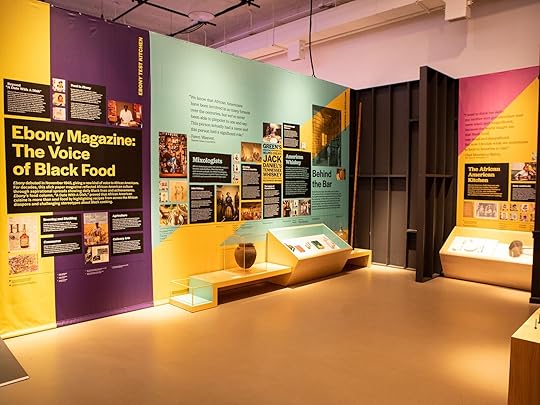
Photo: Clay Williams
So you talked a little bit about the Ebony magazine test kitchen. What aspects of working with the Ebony test kitchen were exciting or valuable to you? And what significance does the magazine have on the story of African American food?That magazine was a symbolic magazine growing up in Senegal. I would look forward to holding it in my hands because it showed beautiful Black people. [Senegal was] colonized just like most of Africa, so at the same time, [people in power] had the same intention of portraying us in an inferior position. And Ebony came in and just presented us as beautiful, happy. It was a celebration of all that in so many aspects, and I wasn’t even speaking English at the time. But I could just spend time reading and looking at the pictures in Ebony and feel joy and pride. And there were recipes too that would come with the magazine. It turns out that those recipes were being developed in this test kitchen. So when we found out that there was a test kitchen that Ebony had somewhere in storage in Detroit that was ready to go in a dumpster somewhere that needed to be recovered and restored, it made sense because that magazine was an essential read for African American culture during those times of trouble. It played a role just like all the other cultural elements played a role, like jazz music, in keeping us centered in this heritage that we are passing on to different generations. You know how influential media is. So often, the media portrays us in such a terrible light, which was certainly the case for North America. And Ebony was the other voice to say, that’s not true — you’re lying. We’re not ugly. We’re beautiful. This is us.
And Ebony was introducing the reader to African American life, which was a life to be desired. There were great entertainers here, successful doctors — there were all kinds of profiles showing African Americans in their splendor. And the food was also a big thing too, bringing recipes every month. That food is supposed to nurture the community. It’s more than just putting nutrition into your body. It’s nurturing your community and the food that we serve into our homes, food that’s been passed by our mothers from their grandmothers and their grandmothers, and so on. And you go all the way back to Africa, as I mentioned, the food is coming through the Middle Passage. So this is food that really carries a message. That’s food that, when you enjoy it, you’re also looking at how our people have not only been able to domesticate these ingredients and create some sort of alchemy, taking raw ingredients and turning it into this delicious gumbo. Hundreds of years later, we are still eating it. It’s a kind of time traveling by just having a quick lunch of gumbo or jambalaya.
What do you hope people leave with once they finish the exhibit? What new knowledge or perspectives is essential that guests come away with?First of all, I hope people leave and become somewhat ambassadors of this message that we are telling America and the world in their own ways because people each have their own way of spreading messages. Just make sure that this conversation continues. It could be continuing on your table. It could be a way of inspiring the way you’re eating – it could be more intentional. I also hope it could help people realize the need to act upon not only supporting this food culture but giving credit to our ancestors for bringing it here. This is a food culture that’s so resilient – having transcended hundreds of years of the most horrible hardship, and yet we are still serving it in such a beautiful and delicious way. So this is a food culture that is a testimony of what our African American culture is – a strong, beautiful, resilient, joyful people and culture. And this is what we should all aim to be. We are a model for this America. You know, this is what America should strive to be. So, after seeing the exhibit, that work should be inspiring us.
And we should also definitely be more inclined to support Black businesses, particularly Black food businesses. The ugly food system that got us in this situation we are in today – when we talk about climate change, when we talk about chronic diseases that we are facing, when we talk about the food deserts and the poison that’s being fed into our communities; Black businesses are the answer to that by bringing our culture and we need to support them for them to thrive and to keep them growing and serving our community the right food. We’re here to nurture our communities and heal us from our trauma. 
Watch: A Look Inside One of the Most Extravagant Hotels in the World

We hope you love the stays we recommend! Just so you know, Matador may collect a small commission from the links on this page if you decide to book a stay. Listed prices are accurate as of the time of publication. See our full Advertiser Disclosure here.
When it comes to extravagant hotels, there’s luxury, and then there’s the Emirates Palace Mandarin Oriental. Case in point: walls embedded with gold and silver for a distinct shine, an indoor ballroom lined with palm trees, and a private beach with pristine white sand imported from Algeria.
And then there’s the rooms.
@epic.stays Wait for the price reveal
:#EmiratesPalace #AbuDhabi #UAE #dubai #luxuryhotel #traveltiktok ♬ love nwantinti (ah ah ah) – CKay
I recently had a chance to explore the grounds and rooms that make Emirates Palace such a draw. I make a living putting words together, but it was hard to know what to say other than repeating my questions to make sure that my notes were right. (Yes, there really is 24-karat gold leaf stretching across more than a million square meters, and Emirates Palace is the only hotel with an in-house gold leaf specialist on staff).
Emirates Palace is owned by the government of Abu Dhabi, and world leaders stay here during official state receptions. There are 394 rooms and suites, and the video above is from when I took a look inside one of the most extravagant suites: the 7,320-square-foot, three bedroom palace suite. All this luxury comes with an eye-catching price tag: 43,500 durham, which is about $11,800.

Photo: Emirates Palace Mandarin Oriental
After the tour of the room, I stopped by Le Café for the Palace Cappuccino (70 AED, or about $20), which, naturally, comes topped with 23-karat gold. And while that was the only precious metals I consumed, there’s the option for a gold-flaked camel burger (about $36) or gold-flaked salmon (about $33). It’s a popular stop — Le Café suggests reserving a table 24 hours in advance whether you’re stopping by for afternoon tea service or a quick camel milk ice cream.
Le Café is one of 13 places to dine at Emirates Palace. The much heralded Hakkasan is included on that list too, as well as restaurants that focus on Emirati cuisine like Mezlai.
A short list of some of the other jaw-dropping amenities:

Photo: Emirates Palace Mandarin Oriental
For staying active during your stayTwo 24-hour fitness centersFitness instructorsTennis and padel courtsMore than 6 kilometers of jogging paths in Emirates PalaceComplimentary bicyclesFootball fields
Photo: Emirates Palace Mandarin Oriental
For business travelers7,000 square meters of conference spaceThe largest hotel auditorium in the world with space for 1,100 guestsBallroom with space for 2,400 guestsMore than 40 meeting rooms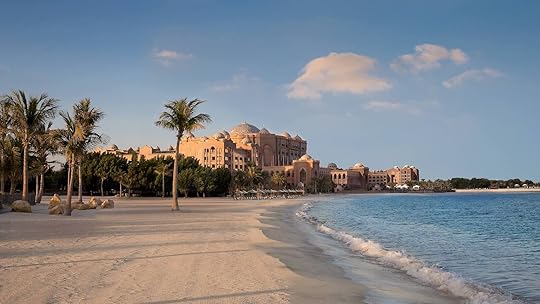
Photo: Emirates Palace Mandarin Oriental
For relaxationA 1.3 kilometer private beach with Algerian white sandTwo resort poolsA 1,500-square-meter spa with private treatment roomsA traditional Moroccan hammamTwo spa jacuzzisTwo spa steam roomsAn ice cave in the spaThe hotel opened in 2005, and was the most expensive hotel to build when it opened in 2005.
You don’t have to be a millionaire to see the Emirates Palace for yourself. The restaurants are open to the public. To get the full once-in-a-lifetime experience with a booked room, however, you’ll have to dip pretty deep into your savings.
The 10 Kinkiest BDSM Dungeons in the US for Couples and Singles

You know that slightly kinky fantasy you have? It probably isn’t all that weird: According to a sexual diversity study conducted in the US, more than 22 percent of sexually active American adults engage in role-playing, while 30 percent have tried spanking. Another survey found that nearly half of the 1,040 people surveyed were interested in kink, even if they hadn’t had the opportunity to explore it. Whether you’re familiar with the words ‘collaring’, ‘subdrop’ and ‘figging’ — or you think mummification is something only done in ancient Egypt, BDSM dungeons make a great place for the sexually curious to turn those kinky daydreams into reality. And while the word ‘dungeon’ might conjure up a very specific set of images, fear not: all tastes, experience levels, and types of person are welcome here (so long as they’re respectful).
Before you submit to any ‘dominant’ you find online, hold on for just one second: BDSM involves you putting your mind, emotions, and quite possibly your genitals in the hands of someone else — so make sure you pick someone who knows what they’re doing. To help you along, we’ve whipped up this list of 10 of the best BDSM dungeons the US has to offer.
Best BDSM dungeons in New YorkBest BDSM dungeon in GeorgiaBest BDSM dungeon in TexasBest BDSM dungeons in CaliforniaBest BDSM dungeon in FloridaBest BDSM dungeons in New York1. Pandora’s box, New York CityOriginally founded and managed by Mistress Raven in the mid-’90s who, at the time, was one of the most famous dominatrixes in America, this legendary venue featured in Nick Broomfield’s documentary Fetishes — as well as a book by photojournalist Susan Meiselas, plus numerous magazine articles. The facility is now run by a collective of professional Dommes and subs who specialize in pretty much every discipline your kinky mind could whip up… and they’re more than happy to show newbies the ropes. Themed rooms range from traditional (think medieval torture chamber and schoolroom) to more niche options: the pink boudoir puts the myth that BDSM = red and black to rest.
Are couples welcome? Yes
Do non-cis-female Doms/subs work here? The dungeon is staffed by cis females, but there is a private playroom for hire — so if you can source your own kink partner, you’re ready to roll.
If you’re done with dark dungeons, here’s one that offers something a little different: There’s a pretty pink crossdressing room for those who want to activate their girlie side, plus a wrestling ring, a Victorian-themed room, a vintage studio, two medical rooms, a classroom, castle chamber, leather room, and industrial-themed ‘blue room’…phew.
Handily located in Midtown Manhattan, this NYC kink-stitution is run by over 20 pros who offer patrons a range of specialisms, including the unique opportunity to be publicly humiliated: As their website says — “We will be happy to parade you through our spacious dungeon so that all of our gorgeous Mistresses can have a proper laugh at your predicament. If you are an exceptionally amusing case, we might even take you to a fetish club so that the patrons can also enjoy your humiliation.” Who’s in?
Are couples welcome? Yes
Do non-cis-female Doms/subs work here? The dungeon is staffed by cis females, but there is a private playroom for hire.
Established in 1997, this spanking club has earned its reputation as an institution in the world of CP (that’s Corporal Punishment for those unacquainted), and its pedigree is recognized across the country. Like all the venues on this list, it’s big on safety: there are strict house rules, plenty of helpful resources, and single males looking to attend a party must make a reservation before they join.
While the club doesn’t offer pro services, it’s is run by the highly experienced Ms. Margaret who’ll answer any questions and help you find your way. There are also events, including a biannual weekend trip to the mountains where spanking fans can let off steam (and rest sore bottoms) with themed activities, cocktails, and jam sessions for the musically inclined.
Are couples welcome? Yes
Do non-cis-female Doms/subs work here? There are no pros working there, but the club welcomes all genders and orientations.
Step inside one of the oldest BDSM training venues in the world. This decadent chateau in upstate New York has been in operation for over 29 years and has well earned its reputation as a high class spot for kinky types. It’s a training ground for Mistresses and Masters, couples and slaves — so if you’re just starting out, here’s your spot.
Run by Mistress Couple and Master R, La Domaine doubles up as a bed-and-dungeon: couples staying overnight can enjoy in a BDSM furniture-bedecked room, and erotic library, plus gourmet dinners served by none other than the Domaine slaves. As if that wasn’t enough, there are workshops, seminars, events — plus chocolate tasting to sink your teeth into.
Are couples welcome? Yes
Do non-cis-female Doms/subs work here? Yes
Founded in 2003, this iconic dungeon boasts the largest playspace in Atlanta. No professional dominants or subs work here, but you’re more than welcome to invite your own. Rooms here are lavish and well-designed: expect lashings of black leather, red drapes and glittering chains, with a special shout-out to their ‘web prysm’ — a giant chain spider web — and its aftercare room, which is full of squishy bean bags for chilling out on post-play.
Also on offer is a calendar of events aimed at seasoned pros and newbies alike: there’s sub school, munches (that’s casual kink-community get-togethers for the layperson), rope tying classes and more.
Are couples welcome? Yes
Do non-cis-female Doms/subs work here? The dungeon is staffed by cis females, but there is a private playroom.
Under the auspices of veteran Domina Shannon — a revered Dominatrix with over 15 years of experience — this kinky hideaway is run collectively by five professional Dominatrixes who’re on-hand to put your obedience to the test. As if this wasn’t good enough, this dungeon has another jewel in its crown: it’s stocked to the rafters with an array of custom toys and furniture, much of which has been hand-crafted by artisans. Take the St. Catherine’s Wheel for a spin, or go medieval and take a turn in the stocks.
Are couples welcome? Yes
Do non-cis-female Doms/subs work here? The Vault is currently run by cis females.
Located just 10 minutes south of the Las Vegas strip, this world-famous dungeon is run by Steel Bond, a leather Daddy who’s been wielding whips for over 30 years. Over that time, he’s amassed an impressive array of gear and fetish knowledge — so whatever predicament you two cook up, you know you’ll be in safe hands. Take your pick from kennels, isolation boxes, and bondage chairs (four and counting), or get yourself in a real bind and let Bond wrap you up in duct tape and rope.
Are couples welcome? Yes
Do non-cis-female Doms/subs work here? Yes: This is a space for gay men.
Run by the devilishly strict Headmistress Cyan, Sanctuary LAX has everything you need to while away a few kinky hours: the house pros are here to help turn your fantasies into reality. The best thing about this dungeon is the sheer range of professionals who work here: you’ve got a mix of genders, ages, Masters, Mistresses, subs and switches — all with their own profile page, so you can get to know your pro before you book. A stone’s throw away from LAX, it’s the ideal spot if you’re traveling for work or pleasure. And if you miss your flight? No problem: this dungeon offers overnight rentals. That’s way better than forking out for a cheap motel room.
Are couples welcome? Yes
Do non-cis-female Doms/subs work here? Yes
This non-profit organization has a mission: to educate the sexually curious and welcome all into the world of BDSM. If you’re a bit nervous about stepping into kinkier pastures, worry not: this is a safe, judgment-free zone that has earned a reputation as the place to go for those just starting out.
Facility-wise, there’s a big main room, plus seven — that’s SEVEN — themed rooms to explore, each well stocked with all the furniture and toys you could ever need. While there are no pros working there (it’s entirely staffed by volunteers), there are experts on hand to help you out, plus a packed calendar of kink-themes classes and other events designed to make the uninitiated feel right at home. Check out their pinned tweet to get started.
Are couples welcome? Yes
Do non-cis-female Doms/subs work here? No pros work here, but Threshold welcomes those of all genders and orientations.
Tired of all the black and red? Welcome to Mistress Mercy’s dungeon, a white, sparkly playspace that features one of the only ABDL (that’s Adult Baby/Diaper Lovers) playrooms in the US. The quite frankly adorable nursery comes complete with a crib, pacifiers, and an array of outfits to choose from, while The White Room — a traditional dungeon, save in color scheme — comes equipped with a cage, wooden pillory and spanking bench, among other instruments designed for humiliation and (consensual) pain. There’s also a ‘sissy boudoir’ room, which comes well-stocked with frilly outfits and more jewelry than you can shake a stick at. Ideal or transforming even the most manly of men into a demure little princess.
Are couples welcome? Yes
Do non-cis-female Doms/subs work here? The dungeon is currently run by cis females. 
2022 ideas for solo female travelers

No mere trend: Solo female travel is here to stay. Women around the world are getting out of their comfort zones to discover the challenges and rewards of planning and executing a trip all on their own. Solo travel encourages confidence, allows you the freedom to do exactly what you want on a trip without having to compromise, grants total immersion in a different environment and culture, and gives you the chance to connect with locals and other travelers. Whether you’re looking to make new friends while on the road, spend all your time hiking through remote national parks, or eat your way through every restaurant and food stand in a new city, there are tons of options to choose from when it comes to selecting a solo travel destination that will fit your personality and trip goals. These offerings range from captivating landscapes to ancient cities to vibrant food scenes. So no matter what type of adventure you’re out to have, we’ve got you covered: These are the best places for solo female travel for 2022.
We hope you love the spaces and stays we recommend! Just so you know, Matador may collect a small commission from the links on this page if you decide to book a stay. See our full Advertiser Disclosure here.
1. For first-timers: Iceland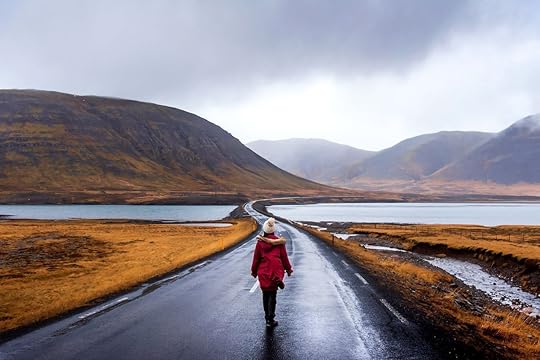
Photo: Creative Family/Shutterstock
Some may say Iceland’s reign as the must-visit destination for solitude-loving adventurers and photographers is coming to an end with the demise of its low-cost airfare options. Well, if interest in Iceland is waning, that’s good news for solo travelers as there will be fewer crowds to contend with, and you’ll get all those amazing landscapes to yourself.
Solo travelers will find a great base camp in the capital city of Reykjavik, which, thanks to the boom, has blossomed into a truly cosmopolitan city full of both local and international dining options, diverse shopping, cultural diversions like museums and tours, and more. It’s also extremely walkable and easy to navigate solo.
From Reykjavik, it’s easy to branch out and explore nearby attractions like the Blue Lagoon and Black Sand Beach; in fact, many of southern Iceland’s most popular sites are within driving distance of the city. You can either choose to rent a car and explore on your own or take a group tour if you’d like to meet new people, especially during the high season months of June to August. But 2020 promises to be an especially good year for solo travel in Iceland because, in an effort to reduce crowds at overrun sites on the southern half of the island, Iceland’s tourism board has been improving infrastructure to promote more off-the-beaten destinations further afield like the Westfjords or the northern reaches of the country.
Furthermore, there’s no language barrier, with 99 percent of Icelanders speaking fluent English, and their friendly, open cultural attitudes make it easy to ask locals for help or advice. Plus, your tourism dollars will be supporting a country that ranks first in gender equality, having had female presidents, taken on the gender pay gap, and possessing a culture that is supportive of strong women — you won’t even get cat-called here.
The sole caveat would be to always be careful when venturing out into the landscapes alone; Iceland’s nature is beautiful but can be deadly due to extreme weather, so if you are off exploring on your own, check the weather, bring the right gear, and make sure someone knows where you’re going.
Where to stay:
Photo: Airbnb
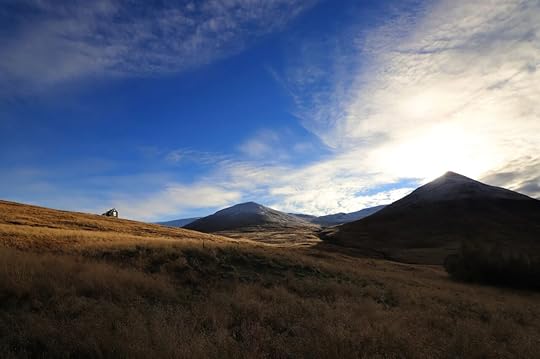
Photo: Airbnb
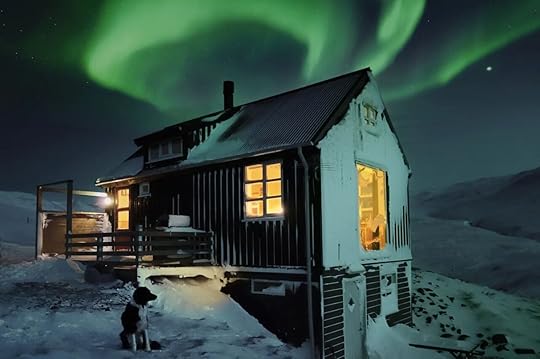
Photo: Airbnb
Stay close to Reyjakvik’s downtown and all it has to offer in this artsy, contemporary apartment with fully-equipped kitchen, balcony, and parking space is within walking distance of tons of dining and shopping, or escape to the countryside to watch the Northern Lights from this cute, remote cottage.
2. For the trailblazers: Saudi Arabia
Photo: Hafizzuddin/Shutterstock
For years, Saudi Arabia remained largely closed off from the outside world, accessible mainly to those undertaking the Hajj pilgrimage to Mecca. But the kingdom is opening up to visitors, with the release late last year of a new tourist visa for 49 different countries, as well as relaxed dress rules for foreign women such as not requiring the use of an abaya (the traditional long, black dress that covers Saudi women’s body and hair). With traditional Arab hospitality fostering a culture of safety and respect, increased access for both foreign and Saudi women to travel at leisure, and the fact that some tour companies now hire female guides, Saudi Arabia is clearly taking steps to prove it’s a modern country for modern women, especially solo travelers.
As with many Middle Eastern destinations, Saudi Arabia’s past sits juxtaposed with its present, with ancient archeological sites a short drive from innovative, 21st-century hubs of technology and commerce. The capital of Ridyah is chock-full of historic buildings, like the Al Murabba Palace, but also modern skyscrapers, cutting-edge museums, and luxe shopping and dining, all accessed via the favored mode of transport: Uber.
The country is home to five different UNESCO World Heritage sites, including the spectacular Mada’in Saleh, a stone-carved palace made by the same empire that built Petra. You can pound the pavement in cities to visit classic markets, fortresses, and cafes (coffee culture is huge here) or head out into the desert on trekking expeditions to the Edge of the World, a prominent rock pinnacle overlooking the desert. Go to electronic music festivals, dive or swim in the warm waters of the Red Sea, stroll along the stylish Jeddah waterfront, view the spectacular architecture in Medina… really, the list goes on and on.
There is still some gender segregation that female visitors will have to deal with (like male-only pools or stores), and dressing modestly is encouraged, but overall, solo travelers who have visited since the visas became available have reported feeling safe, comfortable, and at ease. Still, do your research before going: Saudi Arabia’s human rights record is far from clean, so concerns about spending your time and money here are valid.
Where to stay:Explore the capital city of Ridyah from this affordable, stylish apartment with tons of amenities, or splurge for this private ocean view loft in the coastal city of Jeddah.
3. For the foodies: Mexico
Photo: PR Image Factory/Shutterstock
Mexico is a thriving, vibrant, and welcoming destination for eager travelers looking to dive into a new culture, language, and lifestyle. Oh, and food.
Mexico City is one of the great foodie cities of the world, where you can have everything from Japanese food that’s on-par with what you would find in actual Japan to tacos so good they’ll give you an existential crisis. Some of the world’s most celebrated fine-dining restaurants call Mexico City home, but the street food here is also legendary. At night, you can hop between trendy mezcal bars and historic cantinas. Between all the eating, try to make time to walk the city’s many vibrant barrios, visiting local artisan shops, galleries, and world-class museums. Mexico City is renowned for attracting ex-pats, so you’re bound to meet people from all over, either passing through or who’ve lived here for ages.
Venturing further afield, Oaxaca is the home of that oh-so-hip-right-now tipple, mezcal. Around the state, you can visit the traditional palenques where the agave hearts are cooked and then ground down and mashed to ferment into mezcal. Oaxaca City is another big foodie destination, as well, and is famous for its street food and regional dishes like posole, mole, and chapulines (grasshoppers.) No matter where you go in Mexico, you’re bound to find some great eats.
Where to stay:
Photo: Airbnb

Photo: Airbnb

Photo: Airbnb
In Mexico City, stay in the trendy Condesa neighborhood in this sun-filled, modern loft, and in Oaxaca, soak up the view from this modern penthouse apartment in the city center.
For a larger selection, here’s a list of our favorite Airbnbs in Mexico City.
4. For Mars on Earth: Jordan
Photo: Simbarashe Sakuinje/Shutterstock
Even amid ongoing conflicts in neighboring countries, Jordan’s staid safety and security, open and welcoming culture, friendly and helpful locals, hip city life, and out-of-this-world landscapes have made it a must in the solo travel world.
Sitting right at the point where Africa meets the Middle East, this multicultural country is home to some of the most amazing archeological finds on Earth, making it a must-visit for lovers of culture and history. Naturally, the most famous site is the ancient sandstone city of Petra. But there’s much more, like Bethany Beyond The Jordan, where it’s said Jesus Chris was baptized, or the ancient amphitheater and free-standing columns of Jerash. Urbanites will find much to enjoy in the capital of Amman, with museums, ancient architecture, and souk markets to visit during the day. Once the sun goes down the city’s nightlife scene takes over at flashy dance clubs or chill shisha bars. Amman is also a great place to experience Jordan’s delicious cuisine, such as falafel, kanafeh, and mansaf. From Amman, it’s also an easy day trip to the Dead Sea, where you can feel weightless floating on the heavily salted waters.
Outdoor and adventure travel has also taken off in Jordan in recent years thanks to its expansive deserts, red rock mountains, and meandering canyons. Solo hikers and backpackers are rapidly falling in love with the Jordan Trail, a multi-day backpacking trail spanning the entire country. It’s a popular route, so it’s easy to link up with a group or make new friends along the trail to travel with. Along its 400 miles, you see and experience the best of Jordan, including Petra, the Martian-esque landscapes of Wadi Rum, and the sparkling shores of the Red Sea. Along the trail, you can also learn about traditional Bedouin culture by visiting or even staying at one of their camps.
As a country with liberal attitudes toward women’s rights, female solo travel here is on the ups, making it easy to get around on your own or to join a group. Solo travel reviews of Jordan couldn’t be more glowing.
Where to stay:In the capital city of Amman, you’ll find plenty of central, budget-friendly rental options like this cute tiny house that comes with a kitchen, Wi-Fi, and parking, or this sun-drenched rooftop garden apartment.
5. For nature-lovers: Chile
Photo: Anton_Ivanov/Shutterstock
Chile has climbed the charts in recent years to become a top destination, and now, at the height of its boom, it’s fully ready to embrace solo travelers. Getting around the country by bus, low-budget airline, or car has never been easier. Hostels and hotels up and down the country are stuffed with international visitors. Although most Chileans outside of Santiago or major tourist towns don’t speak much English, they are extremely friendly people who are always eager to offer advice or aid.
And that’s just the logistics. Then there’s what to do. If you’re visiting in summer, there’s trekking or hiking among the mountains and glaciers of Patagonia, rafting past volcanoes in the Lakes District, wandering the colorful streets of the seaside city of Valparaiso, wine-tasting in Casablanca, and stargazing in the Atacama Desert. In winter, there’s world-class skiing or snowboarding outside the capital city of Santiago, which is coming into its own as a cosmopolitan hub, with a vibrant foodie scene, fun and quirky neighborhoods, and excellent cultural attractions like historic buildings and museums. Chile is also one of the best places to get to Easter Island, where you can visit the world-famous Moai statues, hike up volcanoes, try traditional foods, and watch local dances.
Where to stay:
Photo: Airbnb
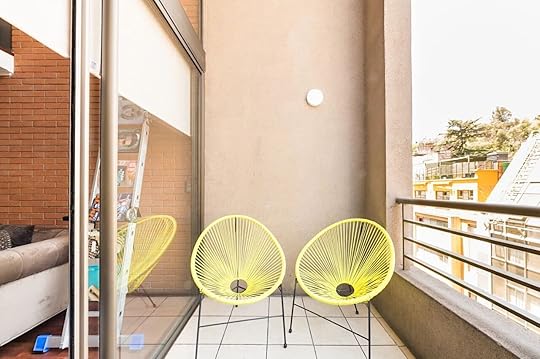
Photo: Airbnb

Photo: Airbnb
Unwind with a glass of wine on the city view terrace of this chic loft in Santiago’s hip Bellas Artes neighborhood, or explore the upscale Providencia neighborhood from this minimalist apartment.
6. For the ‘gram: Morocco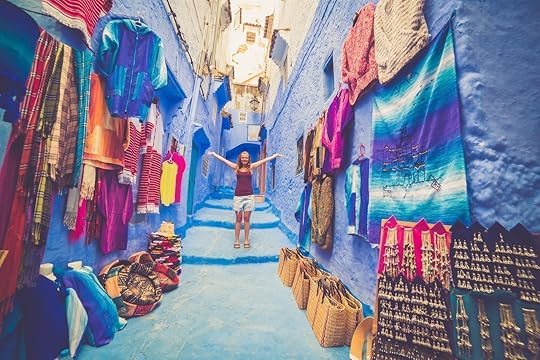
Photo: illpaxphotomatic/Shutterstock
Fashionistas, design lovers, and aspiring influencers take note: Morocco — with its multicultural European, Arabian, and Berber influences; splendid cities of maze-like markets and elegant architecture; and picturesque backcountry — should take top priority for your next solo travel adventure. Morocco is one of Africa’s safest destinations, and the only thing solo travelers should be aware of is dressing conservatively in this largely Muslim country. Morocco is also really easy to navigate thanks to an extensive public transit system.
As Africa’s first-ever City of Culture, Marrakech is a great jumping-off point, packed with museums, galleries, and shops. Two must-visits are the calming Majorelle Gardens, populated with unique plant life and a beautiful Art Deco house, and the chic museum honoring designer Yves Saint Laurent who lived in Marrakech for a number of years. Shoppers will have a field day in the famous medina, a teeming marketplace stocked with everything from colorful piles of spices to opulent rugs. The city of Fez is also famed for its medina, and the varied architecture of cities like Casablanca, Tangier, and Chefchaouen (a city of entirely blue buildings) makes them perfect for exploring and photoshoots.
As fabulous as Morocco’s cities are, it’s well worth getting out of town to explore the country’s deserts and mountains, like camel-riding to the golden dunes of Erg Chigaga. The rugged Atlas Mountains are especially great for trekking and hiking, and the summit of Mount Toubkal, Africa’s highest peak, is easily achievable. And there’s no better guide to help you navigate the mountains than Hafida Hdoubane. In 1994, she became Morocco’s first female mountain guide and now leads trekking tours both for international tour operators like Wild Women Expeditions and with her own tour company. She also provides access to traditional Berber villages in the region, acting as an interpreter so her clients can learn more about the indigenous Berber culture and way of life. And now, the example Hdoubane has set is opening the doors for more women to become guides as well.
Where to stay:In Marrakesh, treat yourself to a sunny modern apartment with rooftop pool for less than a hundred dollars a night, or a lushly-styled private room in a traditional riad that has a central courtyard with a pool.
7. For a good time: South Korea
Photo: Travel man/Shutterstock
With modern infrastructure, efficient public transportation, delicious cuisine, and stunning landscapes, South Korea ranks high on many travelers’ bucket lists. But if you like to party, Seoul needs to be the city you visit this year. This modern city of nearly 10 million is a nightlife hotspot — and not just at traditional nightclubs. There are late-night bars and lounges like The Library, where you can sit back and relax with a book and a good drink until the wee hours, and plenty of LGBTQ-friendly spots. The late-night Dongdaemun night market is also a popular stop, especially for some delicious street eats. But Seoul shines during the day, as well, with ancient palaces like Gyeongbokgung, temples, markets, skyscrapers, and hip restaurants and bars. And, if you’re a K-Pop fan, you’ll be able to indulge your passion at shows and mastering K-Pop dance moves at specialized lessons, and even recording your own K-Pop song in a professional studio.
Getting outside the city with the aid of cheap and efficient public transport via buses or the high-speed railway, you can explore the surrounding countryside, like the tranquil Boseong green tea fields, or Jeju, a volcanic island paradise of sandy beaches, waterfalls, and cherry blossoms that’s known as the Hawaii of South Korea. You can hike to the top of forest-shrouded peaks in Bukhansan National Park, chow down on traditional bibimbap in Jeonju, and learn more about Korean history by visiting the Demilitarized Zone between North and South Korea.
As a country with a strong sense of respect and community, it’s also super easy to make friends with Koreans as a solo traveler. A growing ex-pat scene, largely made up of English teachers, means it’s also easy to meet people from around the world. English is widely spoken, so it can be easy to interact with the locals. It’s also overall more affordable than many other countries in the region.
Where to stay:
Photo: Airbnb
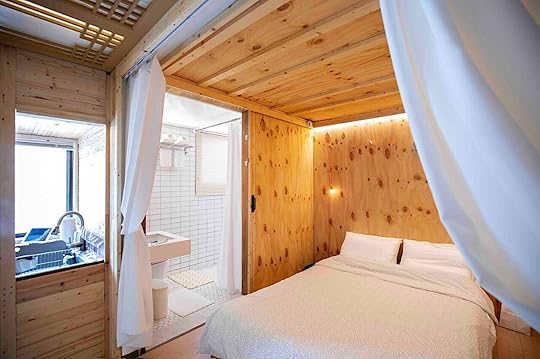
Photo: Airbnb
From its elevated hillside viewpoint, the best feature of this affordable, modern apartment in central Seoul is the rooftop with its panoramic city vista, and this local creative has opened their home to travelers, offering a private room in their comfortable, artsy apartment.
8. For disconnecting: Cuba
Photo: Saga_bear/Shutterstock
There’s a lot of misinformation surrounding US travel to Cuba, but the good news is that, yes, you can easily travel to Cuba with a US passport, and even take a direct flight from select cities — it’s no longer necessary to go through Mexico or Canada. But all that confusion may be to your advantage, as you can discover this rising solo travel star before the hordes do.
You’ve likely heard about Havana’s notorious, rum-fueled party scene, and it doesn’t disappoint, with lively bars, art galleries, and salsa dancing clubs going until the late hours. During the day, either stroll or take a vintage car to view the many historic buildings or districts like the UNESCO-certified Old Havana, visit the Malecon sea wall, browse local stores and artisan shops, and tour a cigar factory.
With taxis readily available in the cities and bus service throughout the island, it’s also easy and cheap to get around and explore spots further afield like the beach at Playa de Estes, Bellamar Caves, colorful houses of Trinidad, and verdant mountains and forests of the Vinales. In rural parts of the island, you’ll find more natural areas for outdoor sports like hiking, boating, and wildlife spotting. And Cuba’s foodie scene is rapidly growing, with hearty, flavorful dishes like ropa vieja served at small paladares (Cuban private restaurants) and street food carts.
If you’re looking to disconnect, Cuba is also a great option as the WiFi is state-controlled and so not always readily available; this means you’ll need to do your research on activities or where to go in advance or, better yet, ask the locals. Another perk for solo female travelers is the chance to stay in a casa particular, where local families rent out spare rooms in their home, allowing guests to stay in a traditional Cuban house and partake of their food and traditions but also get to know other travelers staying with them.
Where to stay:While visiting Havana, book a private room in this elegant, Grecian-inspired residence in the Malecòn Habanero area, or get an entire loft to yourself, with a spacious, sunny living room and plenty of restaurants and attractions close by. 
A version of this article was previously published on February 18, 2020, and was updated on March 2, 2022.
More like thisFemale TravelStop Pitching Solo Female Travelers ‘Safe’ DestinationsMarch 3, 2022
Watch: An Inside Look at the Fabulous Makeover of Sleeping Beauty Castle at Disneyland Paris

For many people, there’s nothing as magical as a trip to a Disney theme park. This year, Disneyland Paris is celebrating 30 years of that magic with a completely upgraded Disneyland Paris castle. In a Youtube video, Disneyland Paris’ Art Director Tracy Eck explains all the “Imagineering” that went into updating the park’s Sleeping Beauty castle (one of two in the world, the other at the Disneyland in Anaheim, California) in all its glory.
The renovation had some setbacks to COVID-19, so it took two years, and a total of 50,000 hours, to renovate. There was an advantage to doing the work during the pandemic, however. Disney Parks typically only remodel and redecorate at night, but with park closures, the crew could work during the day as well, according to Architectural Digest. The refurbishment was not only a chance for a fresh castle for the park’s 30th anniversary, but it was also necessary for the major repairs that often come with 30 years of wear and tear.
“These moments are incredible because we want to make it work, but we never know as long as it’s not done, so it’s kind of an intense moment where we’re precautious,” Eck says in the video. “[But] when it’s done, it’s amazing,”
The project required painters, electricians, gilders, carpenters, tile makers, and roofers to work together to restore the magic. Some suppliers that worked on the project exclusively work with French national and historical monuments — and considering the Sleeping Beauty Castle is the most visited castle in all of France, Disneyland Paris has established itself as an important part of the country’s history.
Some of the most notable changes include rebuilding a few of the towers, which were built offsite and had to be lifted by crane. Eek notes that the castle was entirely repainted by hand with at least 10 shades of pink and more than 41,000 sheets of gold leaf. The roof received 19,900 new slate roof tiles, and the electrical was revamped to add new effects.
The video above shows the mass of activity and energy it took to make the updated version of the castle come to life (for the non-French speakers, turn the English captions on). 
Matador Network's Blog
- Matador Network's profile
- 6 followers





